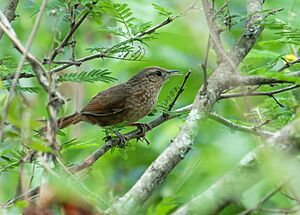Spot-breasted thornbird facts for kids
Quick facts for kids Spot-breasted thornbird |
|
|---|---|
 |
|
| Conservation status | |
| Scientific classification | |
| Genus: |
Phacellodomus
|
| Species: |
maculipectus
|
 |
|
The spot-breasted thornbird (Phacellodomus maculipectus) is a type of bird that belongs to the ovenbird family. You can find this bird in parts of South America, specifically in Argentina and Bolivia.
Contents
About the Spot-breasted Thornbird
Scientists study how living things are related to each other. This is called taxonomy. For a long time, people thought the spot-breasted thornbird was just a type of freckle-breasted thornbird. But now we know they are not closely related at all! Instead, the spot-breasted thornbird is a "sister species" to the greater thornbird. This means they are very close relatives.
The spot-breasted thornbird is a "monotypic" species. This means there are no different types or subspecies of this bird.
What Does It Look Like?
The spot-breasted thornbird is a medium-sized bird. It is about 17 to 18 cm (7 inches) long. It weighs around 19 to 26 grams (about 1 ounce). Both male and female birds look the same.
Let's look at its features:
- Face: It has a light brownish stripe above its eye, called a supercilium. This stripe goes past its eye.
- Head and Back: The top of its head is reddish-brown with some whitish streaks. Its back is a dull reddish-brown color.
- Wings: Its wings are mostly brown. The main flight feathers have reddish edges and dark tips.
- Tail: The middle tail feathers are a dull reddish-brown. The other tail feathers are a dull reddish color.
- Chest and Belly: Its throat is a dull whitish color. Its chest is dark brownish with clear white spots, which is how it got its name! Its belly is brownish-white.
- Legs and Beak: Its eyes are gray. Its upper beak is blackish, and its lower beak is gray. Its legs and feet are gray to greenish-gray.
Where Does It Live?
The spot-breasted thornbird lives in South America. You can find it from the Cochabamba and Santa Cruz areas of Bolivia. Its home range goes south into northern Argentina, as far as La Rioja Province.
This bird likes to live in dry or slightly humid mountain woodlands. It often lives in areas with trees like Alnus (alders) and Podocarpus (a type of conifer). It also lives in scrublands. These birds usually live at heights between 1,000 and 2,500 meters (about 3,300 to 8,200 feet) above sea level. Sometimes, they can be found even higher, up to 3,100 meters (about 10,200 feet).
How Does It Behave?
Movement
The spot-breasted thornbird stays in the same area all year round. It does not migrate to different places.
Feeding Habits
This bird eats arthropods, which are like insects and spiders. It eats both adult arthropods and their young (larvae). Spot-breasted thornbirds usually look for food in pairs. They find their food by picking it off the ground. They also pick food off plants in the lower parts of the forest.
Reproduction and Life Cycle
The spot-breasted thornbird starts to build its nest in September. This is during the spring and summer in the southern part of the world.
- Nest: It builds a nest that looks like a cylinder. The nest is made of thorny sticks and can be about 30 cm (1 foot) tall. Inside, it has a chamber lined with grass. The bird hangs its nest from the end of a tree branch. These nests are usually about 3 to 4 meters (10 to 13 feet) above the ground.
- Eggs: A female bird usually lays three eggs.
- Unknown Details: Scientists do not yet know how long the eggs take to hatch. They also don't know how long it takes for the young birds to leave the nest. More research is needed to learn about how the parents care for their babies.
Vocalization
The spot-breasted thornbird has a special song. It sounds like "10–25 less evenly spaced, complaining notes, 'kew, kééé-keee-keee-keee-keee-keeh…' ". When it senses danger, its alarm call is "a series of squeaky ticking notes".
Conservation Status
The IUCN (International Union for Conservation of Nature) checks on how many animals are left in the wild. They have said that the spot-breasted thornbird is a species of "Least Concern". This means it is not currently in danger of disappearing.
The bird lives in a fairly large area. We don't know exactly how many there are, but their numbers seem to be steady. There are no big threats to this bird right now. It is considered to be fairly common in some places and less common in others. It also lives in at least one protected area, which helps keep it safe.


